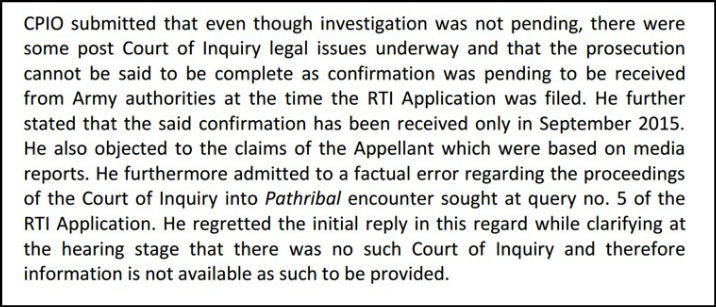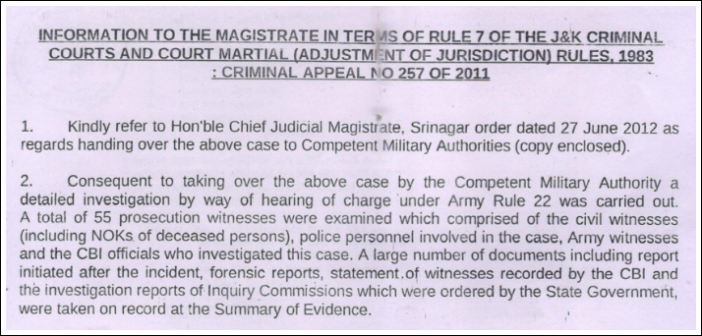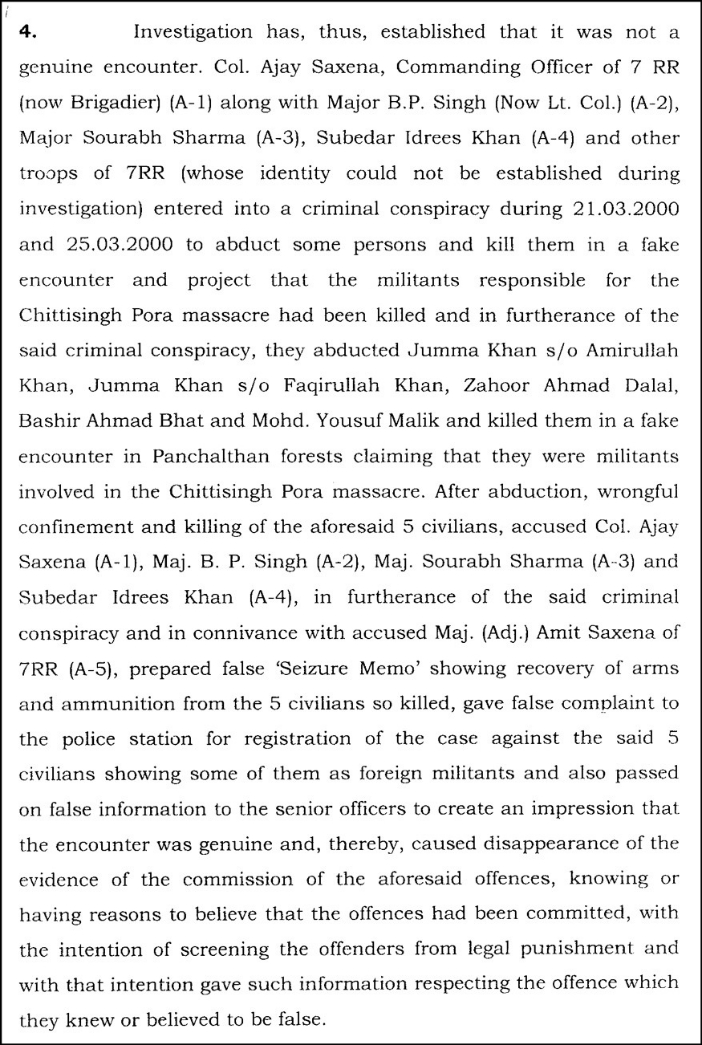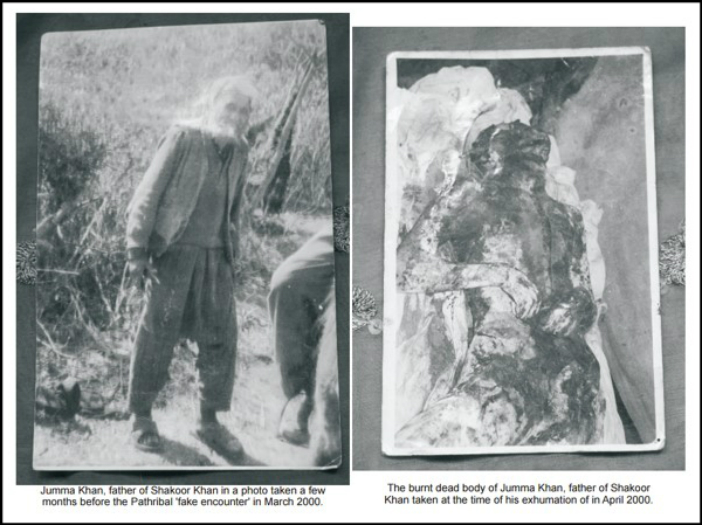[orc]In a recent hearing conducted by the Central Information Commission, the Indian Army said on record that there was no Court of Inquiry in the Pathribal Encounter case.
The Central Public Information Officer (CPIO) of the Indian Army denied information in reply to a Right to Information (RTI) application seeking details of an alleged encounter that killed five civilians in Pathribal, Jammu & Kashmir on March 25, 2000.
Under Section 8(1)(h), a public authority may deny access to information if disclosure will impede the process of investigation or the arrest or the prosecution of persons accused of committing crimes.
However, the Indian Army later clarified that even though the investigation was not pending, there were some legal roadblocks in regard to the alleged encounter’s Court of Inquiry at the time of receiving the RTI in 2015. Dissatisfied with the reply, the petitioner filed a second appeal with the central Information Commission (CIC).
The representatives of the Indian Army as well as the petitioner appeared before the CIC for a hearing on October 25, 2016. During the process of the hearing, the Indian Army representative claimed that there was a factual error in his initial reply and that a Court of Inquiry into the Pathribal Encounter was never instituted in the first place and hence he cannot provide any information regarding it. He also dismissed the petitioner’s claim that media outlets widely reported the Court of Inquiry and stated that the claim is false.

Indian Army’s Investigation
According to documents obtained by Factly, the Indian Army conducted an investigation into this incident including recording and examining of evidence from at least 55 witnesses, forensic reports and other pertaining documents.

The document is dated January 2014 and clearly states that a hearing of charge was conducted, summary of evidence was recorded and that the Indian Army dismissed charges against the accused officers of the 7 Rashtriya Rifles for lack of evidence.
It appears the Indian Army is trying to mislead the petitioner and everybody involved by taking advantage of matters of technicality. While the document states that the matter was investigated by conducting a hearing of charge and summary of evidence, it explicitly does not mention Court of Inquiry. Perhaps it is the only way out for the Indian Army to guard its investigation or the lack if it from the public eye.
Why else would they deny information about a case they closed in January 2014? Why would they suggest that they have some legal matters pending in the case and then retract their statement to say that they never held an investigation into the matter by the name of Court of Inquiry?
It is very clear that the aim of the petitioner is to get the details of the investigation and how the Indian Army arrived at dismissing the charges, while the Central Bureau of Investigation (CBI) had charge sheeted the officers of the 7 Rashtriya Rifles for the same.
CBI vs. Indian Army: History of Pathribal Encounter Investigations
On 20 March 2000, unidentified gunmen in an army uniform massacred 36 Sikh civilians in Chattisingpora in Anantnag district. Coincidentally, the eve on Bill Clinton’s visit to India. The CBI as well as the civil society organizations believe that the 7 Rashtriya Rifles unit staged the encounter four days later in an attempt to showcase that it has nabbed the suspects of the massacre.
In May 2006, the Central Bureau of Investigation (CBI) charge sheeted five officers of the 7 Rashtriya Rifles regiment alleging that the evidence against them confirms that they faked an encounter in March, six years earlier killing 5 civilians in Jammu and Kashmir.

The CBI charge sheet outlines that five civilians were picked up by armed men in military uniform in separate incidents in the Anantnag district of Jammu and Kashmir, the day before the alleged fake encounter.
The families and relatives of missing persons filed reports in the local police stations after not seeing them again. In the process of investigating the missing complaints, the investigation team conducted post mortem on the five dead bodies handed over to the police by the Rashtriya Rifles unit alleging that they were killed in an encounter and might be foreign militants.
- The post mortem reports highlighted that three of the five bodies suffered 95 % burns along with bullet injuries and the other two had their skulls broken, body parts lying separately. If this was an encounter like the Indian army claims, why did the dead bodies have burn injuries? According to the CBI, the burn injuries were inflicted to obliterate the true identities of the dead.

- CBI charge sheet also states that blood samples taken from the bodies to find a match with blood samples of families were found fudged by the forensic laboratories in Hyderabad and Kolkata. The staff of the laboratories took the second samples by coming to Anantnag in person to obtain correct samples. The samples matched the blood samples of the families and relatives who filed the missing persons reports. The families of the five missing persons identified the bodies. This establishes that there was no foreign connection and that they were local civilians who were killed in the encounter. The police investigation also concluded that they were not militants.
- According to the arms and ammunition logs of the Rashtriya Rifles unit, a large number of arms were used. The CBI was of the opinion that it is improbable to use such quantities of ammunition against five unarmed civilians. Even if it was to be assumed that they were armed, none of the unit members of the Rashtriya Rifles suffered any injuries, while they alleged that they exchanged fire.
- By procedure, the army unit engaged in an encounter is supposed to file a signed memo on the spot. The memo submitted by the Rashtriya Rifles unit is typed and the CBI alleged that it was prepared as an afterthought.
The CBI submitted the investigation report to the Chief Judicial Magistrate in Srinagar in 2006. The charge sheeted officers filed a petition in the same year stating that no prosecution could take place before obtaining sanction (approval) by the central government under the Armed Forces (Jammu and Kashmir) Special Powers Act, 1990 (AFSPA) and that the charge sheet should be returned to the CBI.
According to the Armed Forces Special Powers Act, 1990 (AFSPA), no suit, legal proceedings or prosecution can be instituted against an armed forced personnel who might have purported or done anything in exercising the powers of Act.
According to an Amnesty International Report, the Ministry of Defence and Ministry of Home Affairs have stated in replies to Right to Information (RTI) requests from human rights activists in J&K that no sanction has been granted between 1990 and 2012 by either ministry.
The Supreme Court of India gave its final judgment in the Pathribal encounter case in 2012 upholding the officer’s petition to impunity under AFSPA. It directed the Indian army to take a decision within eight weeks on whether they want to try the accused by court martial, a judicial procedure within the army or allow criminal courts the sanction to proceed with the trial. The Indian Army opted to court martial and was handed over the case in June 2012. In January 2014, they closed the case and dismissed the charges against their officers.
Impunity
This is not the first time the Supreme Court of India has given blanket impunity to the armed forces under AFSPA. While it is understood that its hands are tied regarding taking cognizance in the case, it could have used the opportunity to revisit AFSPA, which was introduced as an emergency provision but has remained for over 26 years. It is within the purview of the court to argue that AFSPA is indeed a violation of the Indian constitution and the citizens killed in the encounter have a right to justice that they agree to be fair. Instead it chose to put the case in the hands of the alleged perpetrators and closed its eyes.
A G Noorani, a leading constitutional expert wrote in The Hindu dated July 26,2013, “On January 30, 2013, Justice (retd.) J.S. Verma said: “For anyone to think that sexual assault could in any way be associated with the performance of any official task, well needs to think again.” He added, “What we [his Committee]have said is only that in a case like this, there should be no need for a prior sanction” for the court to take cognizance. Does not this principle apply also to a cold-blooded murder, which is what a fake encounter really is? “
In a 2012 report by International People’s Tribunal for Human Rights and Justice and Association of Parents of Disappeared Persons, states that the clause requiring sanction to prosecute accused officers in spite of evidence “ highlights the pervasive climate of secrecy and non-disclosure and misuse of sanction process.
The cycle of heavy military presence, dissent, resistance, violence, oppression and disappearance is a story too familiar in Kashmir. The Pathribal encounter was one of the most publicized fake encounters in the history of India. But 16 years and hundreds of encounters later, nothing has changed in Kashmir. AFSPA still remains; the military justice system continues to be secretive, self- serving and inefficient and the accused in the case have climbed up the ranks within the army.
Featured Image:Pathribal Encounter


